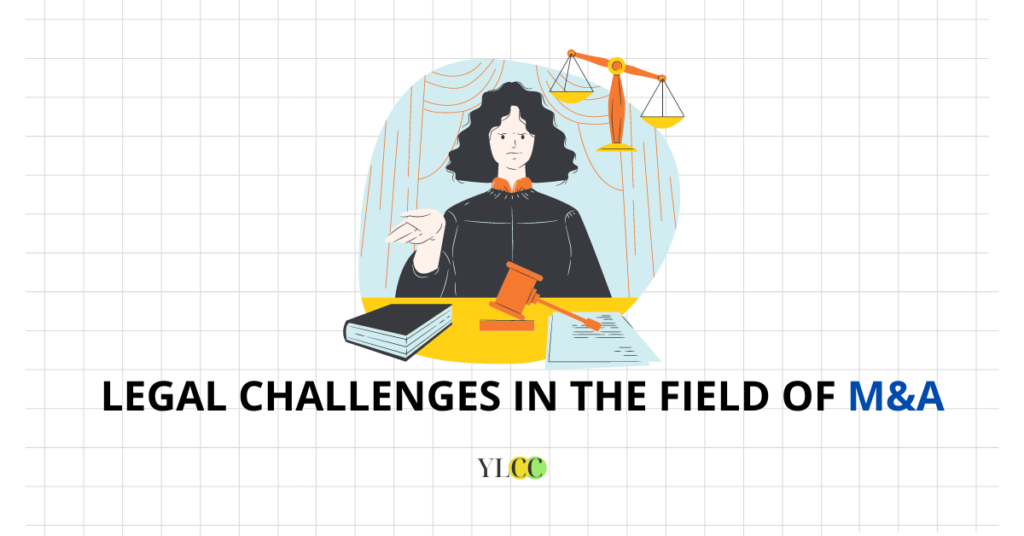
INTRODUCTION:
Mergers and Acquisitions (“M&A“) are often the most effective way for companies to transform their businesses, whether it be through acquiring or divesting of businesses and subsidiaries acquiring technologies or supply chains, investing in new product lines or entering or exiting markets. The following are the main set of activities involved in an M&A transaction:
- Preparing a company for purchase,
- Negotiating the upfront commercial terms,
- Concluding the due diligence investigation,
- Optimally structuring the transaction,
- Drafting comprehensive transaction agreements,
- Project management,
- Implementing legal closing, and
- Advice from the professionals concerning the regulatory requirements and the risk factors of the transaction.
However, there are many legal challenges involved in the field of M&A.
This article discusses the legal challenges faced by the companies while entering or before an M&A transaction.
Challenges with respect to domestic M&A transactions:
In a domestic/private M&A transaction, several factors should be addressed upfront (ideally during the letter of intent stage or as soon as possible after the letter of intent is executed). When considering a deal, the companies (acquiring and target) should consider the following:
a. Transfer of liability: In the absence of an explicit written agreement, the target’s obligations will be transferred to the purchaser upon completing a stock transaction. In a merger, the surviving entity will automatically take over the obligations of the company that has been merged with. In an asset purchase or asset acquisition transaction, only designated liabilities are transferred to the acquirer, whereas liability liabilities not so designated remain the targets’ responsibilities.

b. Taxation issues: An M&A transaction can be either taxable or tax-free. If the conditions of the Income Tax Act, 1961(“ITA”) are not met or the tax authorities allege that they are not met, domestic M&A transactions are subject to tax issues.
For example: As per Section 230-232 of the Companies Act, 2013, a merger of companies is typically conducted through a scheme of arrangement that requires the approval of the High Court. The ITA requires a merger to satisfy defined criteria and qualify as an ‘Amalgamation’ to be tax neutral and these criteria are in addition to the requirements under the Companies Act, 2013.
c. Board approval: Most companies’ constitutional documents give the board the authority to exercise all company powers, except for any matters reserved for the shareholders. In approving a transaction, the board has to approve both the transaction and the terms in their transaction documents. In the event a contract was entered into on behalf of a company without proper authorization, the company could set it aside, rendering it invalid. Therefore, in M&A transactions, it is customary that the buyer and seller review each other’s board approvals before accepting the M&A transaction to ensure that the appropriate authorities are in place. A board approval also confers flexibility for authorizing possible last-minute changes to the transaction documents.
d. Representation and Warranties: Several rounds of negotiations between the buyers and sellers are involved in the process of writing the terms of representations and warranties in M&A deals. The buyer wants an agreement that includes as many representations and guarantees as possible to reduce his or her risk, while the seller wants a smooth exit with as little liability as possible, thereby, leading to disputes between the parties. Therefore, this clause must be drafted in accordance with the terms of both parties.
e. Non-Compete: Through a ‘non-compete clause, the target company makes a promise to the acquiring company not to engage in a business activity that is similar or competitive to the acquiring company after the termination of the deal with the acquiring company. Non-compete clauses/contracts limit job mobility, especially among executives and technical workers. Even workers who don’t have non-compete clauses or have not signed such clauses may be affected by their non-compete termination.
f. The exit of top executives: It is not common for all senior employees of an organization to be on the same page when a merger proposal is presented or when an acquisition is about to take place. Different executives may have different opinions, or some may wish to leave the company may be due to unsatisfactory earnouts or misunderstandings. However, in some cases, the role of an executive is terminated against his will. In such a case the company might have to pay compensation to such executive(s).
Challenges in tech-driven M&A transactions:
a. Intellectual Property: In most data-specific technology companies, algorithms are used to build the platforms and tools that handle data analytics. In cases where third-party data is used in this process, the acquiring company should ensure that such data has full rights to be used by the target company. An acquirer should ensure that the target company has had these rights in the past, and will have them in the future.
b. Cyber Security: The acquirer needs to know if the target company has faced past cyber-security threats which had resulted in the exposure of confidential information of the company. In case, there were any such threats, the acquirer shall ensure if the target company had taken any steps to control or eliminate such threats.
c. Product liability: Generally, product liability arises due to autonomous vehicles and other related systems, such as mobile health, wearables, and fintech. The prudent acquiring company must do the proper due diligence to mitigate the risk of product liability.
Challenges in cross-border M&A transactions:
a. Political or Governmental issues: A company goes through a lot of difficulties when there is the intervention of Central Government or State Governments and/or related provisions during or after the transaction.
b. Instability in financial markets: The economic or financial markets instability can have a huge impact on a cross-border M&A deal. As a result of this instability, the companies can even undergo a restructuring process.
c. Debt considerations: Taking the example of India, it is the Reserve Bank of India that regulates cross-border debt raised by Indian companies. Foreign debt can be accessed by Indian companies through external commercial borrowings or by issuing debt capital to foreign portfolio investors. Thus, a company that has higher leverage are less likely or cannot acquire foreign companies.
d. Undisclosed liabilities: Often, the acquirer company insists on a broad representation of No Undisclosed Liabilities because, from the buyer’s viewpoint, the seller shall bear at least some risk of undisclosed or unknown liabilities.
e. Regulatory / Statutory approvals: In addition to the sectoral regulator or government authorities which may be involved in a cross-border M&A transaction, approval from other authorities is also needed such as the Registrar of Companies (ROC), the Regional Director (RD), the Official Liquidator (OL) and the National Company Law Tribunal (NCLT), etc.
CONCLUSION:
So, given the above challenges/issues/problems in the field of mergers and acquisitions, what is the most difficult scenario to overcome?
This question does not have a simple answer. Therefore, due diligence must be carried out in all aspects of the transaction without any complacency whatsoever.
In addition to the above issues that are to be considered before structuring a cross-border deal or during an M&A transaction, another impactful issue that warrants consideration is the ongoing COVID-19 pandemic.
Every state and country are experiencing changes in their corporate transactions because of the current pandemic. Nevertheless, M&A activity has not completely ceased and in fact, continues to grow from strength to strength.
YLCC would like to thank Nikunj Arora for his valuable inputs in this article.






